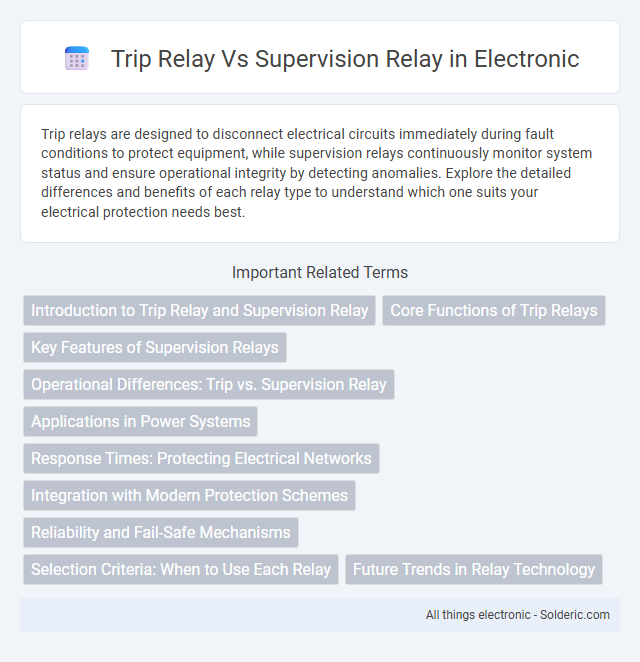Trip relays are designed to disconnect electrical circuits immediately during fault conditions to protect equipment, while supervision relays continuously monitor system status and ensure operational integrity by detecting anomalies. Explore the detailed differences and benefits of each relay type to understand which one suits your electrical protection needs best.
Comparison Table
| Feature | Trip Relay | Supervision Relay |
|---|---|---|
| Primary Function | Initiates circuit breaker trip during fault conditions | Monitors the status and integrity of protection circuits |
| Operation | Activates to disconnect electrical equipment on fault detection | Ensures the trip circuit is closed and operational |
| Application | Used in protective relaying schemes for fault clearance | Used to supervise trip coil continuity and detect circuit issues |
| Response to Fault | Directly trips breaker to isolate fault | Signals supervisory alarm if trip circuit fails or opens |
| Typical Components | Trip coil, relay contacts, fault sensing inputs | Supervisory coil, monitoring contacts, alarm outputs |
| Importance | Critical for safe fault interruption and equipment protection | Vital for reliable operation and prevention of undetected trip failure |
Introduction to Trip Relay and Supervision Relay
Trip relays are protective devices designed to disconnect electrical circuits quickly during fault conditions to prevent damage and ensure safety. Supervision relays monitor the status and proper functioning of other relay systems, signaling anomalies or faults without triggering a circuit disconnection. Both relays are critical in industrial electrical protection schemes, enhancing system reliability and operational safety.
Core Functions of Trip Relays
Trip relays serve as critical protection devices that detect faults in electrical systems and initiate circuit breaker operations to isolate the affected section, minimizing equipment damage and ensuring safety. These relays are designed to respond rapidly to overcurrent, short circuits, and other abnormal conditions by sending a trip signal to disconnect power. Your electrical network relies on trip relays for precise fault detection and prompt disconnection, distinguishing them from supervision relays which mainly monitor system status without initiating trips.
Key Features of Supervision Relays
Supervision relays monitor the integrity and performance of protection circuits, ensuring continuous system reliability by detecting open or short circuits. They provide real-time feedback and fault indication for critical components such as auxiliary contacts, trip coils, and control wiring. Your electrical protection system benefits from enhanced safety and prompt fault isolation with the precise diagnostic capabilities of supervision relays.
Operational Differences: Trip vs. Supervision Relay
Trip relays are designed to initiate circuit breaker operation immediately upon detecting fault conditions, ensuring rapid disconnection to protect equipment and maintain system stability. Supervision relays continuously monitor the status of protective devices and systems, providing alerts or signals when abnormal conditions or failures occur without directly triggering breaker trips. Understanding these operational differences allows you to optimize protection schemes by combining rapid fault clearance with reliable system monitoring for enhanced safety and reliability.
Applications in Power Systems
Trip relays primarily serve to isolate faults by triggering circuit breakers and preventing equipment damage in power systems, while supervision relays monitor the health and operational status of protective devices to ensure system reliability. Trip relays are essential for rapid fault clearance during short circuits or overload conditions, and supervision relays provide alerts for relay failure or control circuit issues before a fault occurs. Your power system protection strategy benefits from integrating both relays to enhance fault detection and maintain continuous system monitoring.
Response Times: Protecting Electrical Networks
Trip relays provide rapid response times typically within milliseconds, ensuring immediate disconnection of faulty circuits to prevent equipment damage and maintain system stability. Supervision relays monitor system conditions continuously and respond slightly slower, focusing on detecting anomalies such as wiring faults or relay failures before triggering alarms or trip signals. Fast operation of trip relays is critical for protecting electrical networks from short circuits and overloads, while supervision relays enhance system reliability by ensuring the trip mechanism remains operational.
Integration with Modern Protection Schemes
Trip relays are essential components in modern protection schemes, providing immediate disconnection signals to isolate faulty sections and prevent equipment damage. Supervision relays enhance system reliability by continuously monitoring circuit integrity and ensuring proper operation of protective devices, enabling early detection of faults or disconnections. Integration with digital protection systems allows these relays to deliver real-time status updates and coordinate with advanced automation protocols for improved grid stability and fault management.
Reliability and Fail-Safe Mechanisms
Trip relays and supervision relays both enhance electrical system reliability by ensuring accurate fault detection and prevention of undesired operations. Trip relays provide fail-safe mechanisms by directly interrupting circuit operations during faults, minimizing risks of equipment damage or safety hazards. Supervision relays continuously monitor the integrity of protection circuits, ensuring fail-safe performance through early detection of relay or wiring failures.
Selection Criteria: When to Use Each Relay
Trip relays are selected for immediate fault isolation in power systems, triggered by conditions like overcurrent, short circuits, or ground faults to protect equipment and maintain safety. Supervision relays monitor the operational status and integrity of circuit breakers or other protective devices, ensuring they function correctly without initiating a trip. Your choice depends on whether the priority is rapid fault interruption (trip relay) or continuous monitoring and ensuring system reliability (supervision relay).
Future Trends in Relay Technology
Trip relays and supervision relays are evolving with advancements in digital communication and smart grid integration, enhancing their reliability and diagnostic capabilities. Future trends indicate increasing adoption of intelligent relays with real-time monitoring, predictive maintenance, and cybersecurity features to protect power systems. You can expect these innovations to improve operational efficiency and system resilience in modern electrical networks.
trip relay vs supervision relay Infographic

 solderic.com
solderic.com